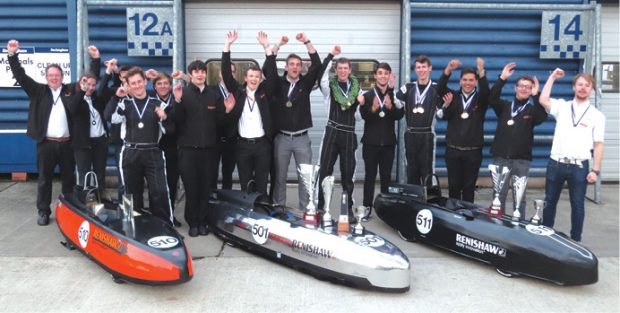
Renishaw apprentices raced to success at Greenpower event in 2016. Image courtesy of Renishaw.
October 1, 2017
Jeremy Way is the CEO of Greenpower, a nonprofit education trust. The organization runs an event in the UK, sponsored by the global engineering company Renishaw. The event challenges students to design and fabricate functioning electric vehicles. We spoke to Way to learn more about this event.
Digital Engineering: Can you provide an overview of the Greenpower Electric Car Challenge?
Jeremy Way: Greenpower’s first event was in 1999. Since then, the initiative has grown significantly. In the UK, we now work with over 600 schools and organizations, involving 10,000 students.
The Greenpower project involves teams designing, building and racing fully functioning electric vehicles. The aim is to introduce young people, aged 9 to 25, to an engineering environment.
In 2016, the number of people involved in all three age categories—IET Formula Goblin, IET Formula 24 and IET Formula 24+—increased. We also continued to expand into new regions, holding the first events in North Wales, South Wales and Luton.
 Renishaw apprentices raced to success at Greenpower event in 2016. Image courtesy of Renishaw.
Renishaw apprentices raced to success at Greenpower event in 2016. Image courtesy of Renishaw.A total of 36% of Greenpower participants are female, which is impressive for a science, technology, engineering and math (STEM) project.
Greenpower began licensing its program abroad in 2015. Successful programs now run in Spain, China, Poland and the US. In the US, there are 96 IET Formula 24 teams and 20 IET Formula Goblin teams. We’ve also seen a growing interest globally, including in Indonesia, Thailand, Singapore and Malaysia.
DE: Can you tell us about some of the designs that are part of the event and how they came to be?
Way: In 2016, for the first time in 12 years of the Goblin category, we launched a new kit car, which we are excited to start seeing on the tracks in 2017. We released our Goblin G2, a second-generation kit car, which is designed and manufactured by KMF in Staffordshire, UK. The assembly process and appearance has made it more appealing to primary schools.
Recently, we asked one of our expert teams to design and build a demonstration car to show how the process does not need to be costly or time-consuming.
Each team designs its own electric car over the course of the season. The teams make numerous modifications to the cars to improve performance.
For example, in 2016, the Renishaw team used Siemens NX software, particularly for performing aerodynamic analysis and part simulations. The software enabled the team to use CAD models, test aerodynamics virtually and ensure there were no mechanical incompatibilities.
To improve the aerodynamic performance of the car, the team reduced turbulence behind the driver’s head by using helmet fairings. Another design improvement was (use of) a round nose cone on the front of the vehicle for better aerodynamics with crosswinds. These would not have been achievable without the software and design expertise of the Renishaw team.
The team also prioritized gearing. Using a gearing system allows drivers to adjust current usage during the race in reaction to changes in conditions and to the different tracks, thus improving the performance of the car. One of the team’s main electronic innovations was the creation of a smartphone display function, which allowed the driver to make appropriate gear choices.
One of the team’s main electronic innovations was the creation of a smartphone display function, which allowed the driver to make appropriate gear choices. The display showed the voltage and current draw during the race. Information could be relayed from an Arduino through a Bluetooth module to the Android smart phone. This meant the driver was able to adjust to use more or less power as appropriate by changing gear to suit the immediate conditions.
In the 2016 Greenpower finals, held at Rockingham Motor Speedway, the Renishaw team of graduates and apprentices achieved first and second place in the Silverline Corporate Challenge.
DE: Can you provide some examples of what the initiative has produced?
Way: In a recent survey, 95% of primary school-aged participants commented that, because of Greenpower, finding out how things work is interesting, which shows the impact the program has had on almost all participants.
More Info
In related news, visit a news story about Renishaw's sponsorship of a Cardiff racing team from Cardiff University in the UK.
Subscribe to our FREE magazine, FREE email newsletters or both!
About the Author
Jim Romeo is a freelance writer based in Chesapeake, VA. Send e-mail about this article to [email protected].
Follow DE





